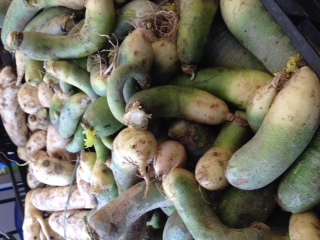May 7th, 2017 by Meryl Danziger | Tags: freedom, inner musician, learning, liberate learning, Muse, music garden, musical garden, planting seeds, teaching | No Comments »
At the Union Square farmers’ market today I saw stand after stand of storybook-perfect-looking veggies until I got to the stand with a sign: “Certified Organic.” These veggies didn’t look storybook—or maybe just a different story. The carrots, for example. Not a single straight, shiny, ready-for-an-evening-out one among them. All sizes and twisty shapes, uneven colors, some sprouting extra limbs. The cabbages, celeries, radishes (THOSE THINGS ARE RADISHES???) were similarly non-conformist. My first thought was something about “Lord of the Flies,” but my second was “Hmm … These have a lot more character, and they look like they’re—enjoying themselves!” It was as though the growers’ willingness to relinquish control and leave the veggies to their own devices liberated them to discover their inner Muse.

Likewise with music learning. I find that the more I am willing and able to assume the role of supporter, collaborator, and resource, rather than be an adult with an agenda, the more my students seem free to engage, thrive, and discover their respective inner musicians. This doesn’t mean that teachers shouldn’t plant seeds: observe what the student is doing and draw on our experience to offer an idea of what might enhance it. But it is a very different thing to offer and to expect. I have become shockingly comfortable having my idea seedlings ignored or rejected. That’s okay! And it often happens that some weeks or months later, the individual who showed no interest in my brilliant idea suddenly or casually starts to do it!
For closure, a quote from a gardener:
So when I make a plea for havoc, what would be lost? Merely the pristine appearance of a garden kept highly manicured, which could be squandered for amiable disorder. Just in some places. Just to give a pull at our primeval senses. A mild desire for the amorphous confusion which will gently infiltrate and, given time, will one day set the garden singing. –Mirabel Osler, from A Gentle Plea for Chaos (A gardening manual)



